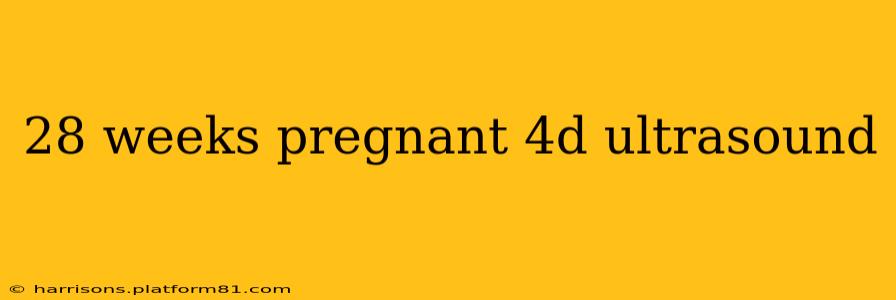Congratulations on reaching 28 weeks pregnant! You're well into your third trimester, and your little one is rapidly growing and developing. A 4D ultrasound at this stage can be an incredibly exciting experience, offering a glimpse into your baby's world with stunning detail. This comprehensive guide will cover everything you need to know about a 4D ultrasound at 28 weeks, addressing common questions and providing valuable insights.
What Can You See at a 28-Week 4D Ultrasound?
At 28 weeks, your baby is significantly more developed than at earlier stages. A 4D ultrasound at this point often reveals:
- Facial Features: You'll likely see your baby's face clearly, including eyes, nose, mouth, and even expressions! It's a truly remarkable experience to see your baby's unique features.
- Body Movements: Your baby is very active at this stage, and the 4D ultrasound will capture their movements, including kicking, stretching, yawning, and sucking their thumb.
- Body Proportions: You'll be able to get a good sense of your baby's size and proportions. The limbs are well-defined, and the body is filling out.
- Hair and Nails: Sometimes, you can even see the beginnings of hair growth on the head and the development of tiny fingernails and toenails.
- Placenta and Amniotic Fluid: The ultrasound also checks the health of the placenta and the amount of amniotic fluid surrounding your baby.
Is a 28-Week 4D Ultrasound Safe?
There's no evidence to suggest that 4D ultrasounds pose any risk to the mother or baby when performed by a qualified technician using appropriate settings. Ultrasound uses sound waves, not ionizing radiation like X-rays, to create images. However, it's crucial to have your ultrasound performed by a qualified medical professional in a reputable facility. Always discuss any concerns you have with your doctor or midwife.
What are the Benefits of a 28-Week 4D Ultrasound?
Beyond the incredible visual experience, a 4D ultrasound at 28 weeks can offer several benefits:
- Early Detection of Potential Issues: Although not a replacement for routine prenatal care, a 4D ultrasound can help detect certain birth defects or developmental issues.
- Emotional Bonding: Seeing your baby's face and movements can strengthen the bond between you and your little one.
- Peace of Mind: For many parents, seeing their baby's health and development can bring immense peace of mind.
- Memorable Keepsakes: You'll likely receive photos and videos of your ultrasound, creating lasting memories of this special time.
What if My Baby Isn't Cooperative During the Ultrasound?
Sometimes, babies are less active or positioned in a way that makes it difficult to get clear images. The sonographer will use various techniques to encourage your baby to move into a better position. If necessary, a follow-up ultrasound might be scheduled. Don't be discouraged if you don't get perfect pictures the first time around.
How Much Does a 4D Ultrasound Cost at 28 Weeks?
The cost of a 4D ultrasound can vary significantly depending on your location and the facility you choose. It's typically more expensive than a standard 2D ultrasound. Check with your insurance provider to see if any portion of the cost is covered. It's also a good idea to call several facilities to compare prices.
Are 4D Ultrasounds Covered by Insurance?
Insurance coverage for 4D ultrasounds is highly variable. Many insurance companies cover only medically necessary ultrasounds, which are typically 2D scans to assess the baby's health and development. Elective 4D ultrasounds are usually not covered. It's essential to contact your insurance provider directly to determine your specific coverage.
Is it Too Late for a 4D Ultrasound at 28 Weeks?
No, 28 weeks is a fantastic time for a 4D ultrasound! Your baby is well-developed, making for clearer and more detailed images. While you can get a 4D ultrasound later, some find 28 weeks to be an optimal time.
This information is for general knowledge and should not be considered medical advice. Always consult with your healthcare provider for any questions or concerns regarding your pregnancy and ultrasound procedures.
